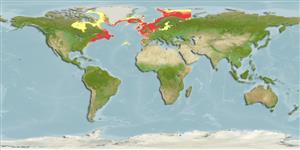Environment: milieu / climate zone / depth range / distribution range
ນິເວດວິທະຍາ
ສັດທະເລ ກ່ຽວກັບ (ຢູ່)ເທິງຊັ້ນພື້ນດິນໃນທະເລເປີດ; ປາທີ່ມີການເຄື່ອນຍ້າຍໃນສະເພາະມາະຫາສະມຸດ (Ref. 51243); ລະດັບຄວາມເລິກ 0 - 868 m (Ref. 58496), usually 50 - 150 m (Ref. 4701). Polar; 3°C - 11°C (Ref. 127841); 80°N - 32°N, 95°W - 49°E
Western Atlantic: Nunavut, Hudson Bay to James Bay and Labrador in Canada to New Jersey in USA; rarely to Chesapeake Bay in USA and Bermuda. Eastern Atlantic: Barents Sea, Iceland and Greenland to Spain (Ref. 4701).
ຂະໜາດ / ນ້ຳໜັກ / Age
Maturity: Lm ? range ? - ? cm
Max length : 61.0 cm TL ຕົວຜູ້/ບໍ່ມີເພດ; (Ref. 58426); 42.9 cm SL (female); ນ້ຳໜັກສູງສຸດທີ່ເຄຍຈັດພີມມາ: 9.5 kg (Ref. 4701); ນ້ຳໜັກສູງສຸດທີ່ເຄຍຈັດພີມມາ: 9.5 kg; ອາຍຸສູງສຸດທີ່ເຄຍລາຍງານມາ: 13 ປີ (Ref. 54207)
ຄີ (ໜາມ)ແຂງຢູ່ຫຼັງປາ (ທັງໝົດ): 5 - 9; ຄີຫຼັງຂອງປາ (ຄີອ່ອນ) (ທັງໝົດ): 9-11; ຄີ(ໜາມ) ແຂງຢູ່ຄີກົ້ນປາ
ກຸ່ມປາກະດູກແຂງ
ຄວາມຖີ່ຂອງກຸ່ມຖ່າຍທອດພັນ
ປາທີ່ມີການເຄື່ອນຍ້າຍຈາກທະເລໄປຫານ້ຳຈືດ ແລະນ້ຳຈືດຫາທະເລ
ປາທີ່ມີການເຄື່ອນຍ້າຍຈາກທະເລແລະໄປໄຂ່ຢູ່ນ້ຳຈືດ
ຄີກົ້ນຂອງປາ
ສັດທີ່ມີກະດູກສັນຫັຼງ
ການຖ່າຍທອດທາງກຳມະພັນຈາກພໍ່ແມ່ຫາລູກ 0; ຄີກົ້ນຂອງປາ: 9 - 10; ສັດທີ່ມີກະດູກສັນຫຼັງ: 28 - 29. First dorsal fin present but covered by thick layer of skin forming a characteristic high crest with embedded spines. Bony tubercles present, arranged in 3 widely separated rows of large flattened tubercles on each side of body. Gill openings large, extend- extending below level of upper pectoral fin ray. Pyloric present 36-79. Ventral sucking disc formed by the modified pelvic fin (Ref. 232).
Basically solitary rather than a schooling fish. They exhibit a homing instinct (Ref. 9737). Adults inhabit rocky bottoms but may occur among floating seaweed. They migrate considerable distances in an annual cycle between deeper waters in winter and shallower waters in summer (Ref. 26141). Maximum depth reported at 868 m (Ref. 58426). Epibenthic-pelagic (Ref. 58426). Juveniles are found among algal clumps in bays and fjords moving offshore as they mature (Ref. 96431). During the spawning season the males become reddish in color on the underside, whereas females turn blue-green. Adults feed on ctenophores, medusas, small crustaceans, polychaetes, jelly fish and small fishes. Valued for their eggs, which make an inexpensive caviar (Ref. 9988). Eaten in Nordic countries, marketed fresh or smoked. Male flesh is most demanded and roe is sold fresh (Ref. 35388).
Eggs are laid in large numbers on stony bottoms (Ref. 9900). Male guards egg-mass aggressively.
Stein, D.L., 1986. Cyclopteridae. p. 1269-1274. In P.J.P. Whitehead, M.-L. Bauchot, J.-C. Hureau, J. Nielsen and E. Tortonese (eds.) Fishes of the North-eastern Atlantic and the Mediterranean. UNESCO, Paris. Vol. III. (Ref. 4701)
IUCN Red List Status (Ref. 130435)
Threat to humans
Harmless
Human uses
ການປະມົງ: ທີ່ມີການຄ້າສູງ; ເຍື່ອ: usually
ເຄື່ອງມື
Special reports
Download XML
ແຫຼ່ງອີນເຕີເນັດ
Estimates based on models
Preferred temperature (Ref.
123201): 0.6 - 11.4, mean 7.1 °C (based on 732 cells).
Phylogenetic diversity index (Ref.
82804): PD
50 = 1.0000 [Uniqueness, from 0.5 = low to 2.0 = high].
Bayesian length-weight: a=0.02630 (0.01091 - 0.06342), b=2.99 (2.78 - 3.20), in cm total length, based on LWR estimates for this (Sub)family-body shape (Ref.
93245).
ຊັ້ນເຂດຮ້ອນ (Ref.
69278): 3.9 ±0.0 se; based on diet studies.
ຄວາມຢືດຢຸ່ນ (Ref.
120179): ຕຳ່, ປະຊາກອນຕຳ່ສຸດທີ່ໃຊ້ເວລາສອງເທົ່າ 4.5 - 14 ປີ (K=0.12; tm=3-5; tmax=13; Fec=100,000).
Prior r = 0.17, 95% CL = 0.10 - 0.27, Based on 1 stock assessment.
Fishing Vulnerability (Ref.
59153): Moderate to high vulnerability (47 of 100).
Climate Vulnerability (Ref.
125649): Low to moderate vulnerability (26 of 100).
Nutrients (Ref.
124155): Calcium = 14 [4, 76] mg/100g; Iron = 0.419 [0.153, 1.089] mg/100g; Protein = 14 [11, 18] %; Omega3 = 0.423 [0.162, 1.406] g/100g; Selenium = 26.2 [8.8, 69.4] μg/100g; VitaminA = 13.4 [2.4, 72.4] μg/100g; Zinc = 0.52 [0.20, 0.90] mg/100g (wet weight); based on
nutrient studies.
